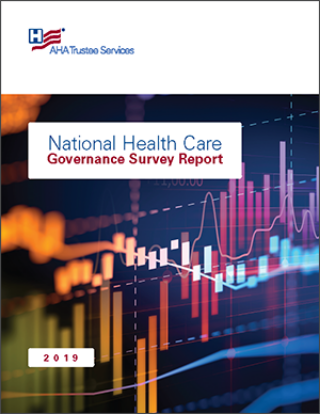
Transforming Governance
AHA 2019 National Health Care Governance Survey Report
Executive Summary
Our nation’s hospitals and health systems continue to adapt to an environment of transformation and pursue new strategies, structures and relationships to address the corresponding challenges and opportunities. The list of issues facing health care organizations are well-known—consumerism; disruptive innovation; providing greater value through new care delivery and payment models; addressing social, behavioral and environmental issues affecting the health and wellbeing of populations and communities; and others. What is now becoming clearer, however, is the magnitude of change these challenges are likely to have on where, when, how and from whom we receive care. They also are beginning to change how we define health and health care itself.
In this context, it is not surprising that the American Hospital Association’s (AHA) 2019 National Heath Care Governance Survey Report describes a governance field in transition. Survey results often reflect how boards within systems are redefining roles, responsibilities and levels of decision-making authority to clarify and effectively integrate governance across multiple boards.
To provide a deeper longitudinal view of health care organization governance, the survey, conducted in 2018, continued to gather data on a variety of questions about board membership, structure and practices. Similar to the 2014 survey, this one also continues to examine findings across all respondents and by system, system subsidiary hospital and freestanding hospital boards.
This survey also includes some additional elements. New survey questions, displays of specific findings by subsidiary hospital boards with varying levels of decision-making authority, and commentary on survey findings from multiple governance experts and practitioners provide focus on contemporary governance issues and broad perspective and insight on survey results. Discussion questions, another new feature of this report, are included to help boards reflect on survey findings in the context of their own structure and practices.
This report includes several sections that can help readers better understand survey results and their implications for board work. They include:
- Survey Methodology, which describes survey design and process.
- Board Composition, which addresses board size, member voting status and member diversity, including participation of Millennials on boards.
- Board Structure and Support, which discusses data on board terms and term limits, board compensation, committees, governance restructuring and use of staff and technology support for governance.v
- Board Practices, focusing on a range of issues related to board member selection, orientation, continuing education and performance evaluation and use of assessment results.
- Performance Oversight, including executive succession and leadership development, accountability and organizational performance
- Board Culture, encompassing data about board meetings; use of, topics covered and attendance at executive sessions; and feedback about the time commitment required for board service.
Positive trends indicated by report findings include:
- Consistent growth in use of routine executive sessions over the past three years, considered a governance best practice.
- Some growth in racial and ethnic diversity of board members.
- A solid majority (about two-thirds) of all responding boards engaging in restructuring efforts to improve their governance.
- Increased use of board portals, also considered a governance best practice.
- Inclusion, by almost half of responding system boards, of board members from outside of communities served to add fresh perspective to board deliberations.
However, there are opportunities for improvement:
- Almost a third of all respondents did not use term limits.
- More than 75 percent either did not replace board members during their terms or continued to reappoint them when eligible during the past three years, resulting in low levels of board turnover.
- More than 70 percent of responding boards did not have a continuing education requirement for their members.
- Some 31 percent did not do board, board member or board or committee chair assessments in the past three years.
- Boards surveyed indicated a growing number of older members and fewer younger members.
- Almost half (49 percent) of respondents did not have a formal CEO succession plan.
Reflecting on the results of the 2018 survey and comparing their own structure and function with survey report findings can help boards gain insight into their own governance practices and performance. Survey results also provide a useful perspective on the state of health care governance in America. They raise important questions about boards and their governance: How are boards rising to meet the challenges of an evolving health care environment, and what key opportunities exist for them to further enhance their own performance and contributions?

